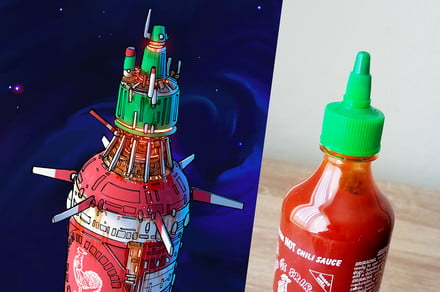As a kid, my parents refused to buy me the action figures that Saturday morning cartoons programmed me to crave. Instead, they insisted that I make do with wooden blocks and other more general purpose toys, with the money-saving argument that this would somehow help build imagination. As a 6-year-old playing with a squared-off chunk of tree instead of a fancy Optimus Prime figure, I didn’t totally buy it. As a 30-something-year-old, I kind of do. And one of the reasons is Eric Geusz.
Like a slightly nerdier Bruce Wayne/Batman or Clark Kent/Superman, Albuquerque, NM-born Geusz has carved out something of a diurnal/nocturnal divide for himself. While working days as a 3D software engineer at Apple, Geusz’s nights have seen him cultivate a growing online fanbase as an artist — largely thanks to his sci-fi drawings transforming everyday household objects into starfighters, futuristic rockets, and space shuttles.
A regular bottle opener? With some Mobius-style flourishes, it’s rendered as an imperious blade-like space leviathan cutting through the stars. An ordinary egg whisk? Try some kind of futuristic satellite or International Space Station-type structure. Barbeque tongs? An A-frame shuttle, which looks like it belongs on some future construction site. A bottle of Sriracha? More like Star-racha! You get the point.
“My favorite one is probably still the can opener,” Geusz told Digital Trends. “As an artist there will be art pieces that you do where you look back and realize you ‘leveled up’, where your skill had a noticeable jump in improvement. It’s one of those.”
Dealing with artist’s block
Ironically, the images which have captured people’s imaginations were never intended to be Geusz’s calling cards. “The idea behind it is to help clear artist’s block,” he said. “Sometimes you’ll be bored sitting there thinking, ‘I want to draw, but I don’t know what.’ Well, a cool spaceship; that’s what! Even the dumbest, most mundane things can be awesome.”
“Even the dumbest, most mundane things can be awesome.”
Fetishizing the everyday, and elevating the mundane into something extraordinary is, of course, something of a national pastime on the internet. And while few of us without the surname Musk or Bezos can relate to spaceships as commonplace objects, anyone prone to a spot of daydreaming can relate to fantasizing that some totally boring desk object, such as an eraser, is actually a shuttlecraft straight out of the imagination of George Lucas.
With that in mind, it’s little wonder that Geusz’s scribblings have earned him an impressive 134,000 followers on Instagram, where he posts under the moniker Spacegoose.
“My favorite [response to this work] is the, ‘I thought I was the only one who did this’ comment which I get a lot,” Geusz continued. “It means it connects with people. I’m glad I can help people rekindle a little of their childhood. There is also this idea that real artists create and imagine things in a vacuum. They stare at a blank white paper and, bam, a masterpiece just appears. But any actual real artist will tell you that is not true at all. Artists use references, and gather inspiration from all sorts of places.”
Making the everyday extraordinary
Geusz isn’t kidding. What he’s doing is part of a long tradition among sci-fi prop designers, who reappropriated other more Earthbound technologies when they were called on to create their futuristic or interstellar designs. This can be both directly (the Psychokinetic Energy Meter from Ghostbusters being an actual 1970s shoe polisher) or indirectly (simply inspiring the look of the design.)
“It’s nice to switch your brain off from being purely analytical.”
“Even the Star Wars ships are World War II airplane and battleship models smashed together,” he said. “I think that misconception makes a lot of people feel like they suck at art or they will never be creative, but being creative is really just looking at stuff from new perspectives.”
A similar thing can be seen the other way around. It’s impossible not to look at the space age rocket designs of the 1960s and not see the influence in the everyday products of the following decades. Devices like the iPad and today’s smart speakers were created as on-screen props for science fiction long before surprisingly similar designs began to pop up in our homes. Heck, tech giants including Microsoft, Google, and Apple have all hired sci-fi writers for the express purpose of writing “design fiction” that will eventually lead to tomorrow’s commonplace commercial products.
So does Geusz’s nightly work as a reinterpreter of the commonplace of the mundane help him with his day job? “Being artistic really helps me with engineering,” he said. “It’s nice to switch your brain off from being purely analytical. It helps me relax from long days of coding and troubleshooting — and I recommend it to everyone as a form of meditation.”
Now if you’ll excuse me, I’m off to stare at the contents of my kitchen cupboard. And, if the results should lead to the next great spaceship design, I’ll drop my parents a call to thank them for not buying me that Optimus Prime figure.
Editors’ Recommendations
-
Tire review: BFGoodrich Advantage T/A Sport LT
-
Here are the best shows on Netflix right now (August 2019)
-
Here are the best Dolby Atmos movies for your home theater
-
CGI faces will soon be indistinguishable from real ones. Here’s how
-
Game companies are working developers hard. The pay isn’t worth it

